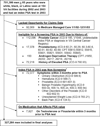Probability of an abnormal screening prostate-specific antigen result based on age, race, and prostate-specific antigen threshold
- PMID: 24439009
- PMCID: PMC3943595
- DOI: 10.1016/j.urology.2013.10.051
Probability of an abnormal screening prostate-specific antigen result based on age, race, and prostate-specific antigen threshold
Abstract
Objective: To determine the distribution of screening prostate-specific antigen (PSA) values in older men, and how different PSA thresholds affect the proportion of white, black, and Latino men who would have an abnormal screening result across advancing age groups.
Methods: We used linked national Veterans Affairs and Medicare data to determine the value of the first screening PSA test (ng/mL) of 327,284 men older than 65 years who underwent PSA screening in the Veterans Affairs health care system in 2003. We calculated the proportion of men with an abnormal PSA result based on age, race, and common PSA thresholds.
Results: Among men older than 65 years, 8.4% had a PSA >4.0 ng/mL. The percentage of men with a PSA >4.0 ng/mL increased with age and was highest in black men (13.8%) vs white (8.0%) or Latino men (10.0%) (P <.001). Combining age and race, the probability of having a PSA >4.0 ng/mL ranged from 5.1% of Latino men aged 65-69 years to 27.4% of black men older than 85 years. Raising the PSA threshold from >4.0 ng/mL to >10.0 ng/mL reclassified the greatest percentage of black men older than 85 years (18.3% absolute change) and the lowest percentage of Latino men aged 65-69 years (4.8% absolute change) as being under the biopsy threshold (P <.001).
Conclusion: Age, race, and PSA threshold together affect the pretest probability of an abnormal screening PSA result. Based on screening PSA distributions, stopping screening among men whose PSA <3 ng/mL means more than 80% of white and Latino men older than 70 years would stop further screening, and increasing the biopsy threshold to >10 ng/mL has the greatest effect on reducing the number of older black men who will face biopsy decisions after screening.
Copyright © 2014 Elsevier Inc. All rights reserved.
Conflict of interest statement
The authors report no conflicts of interest related to the work described in this manuscript.
Figures
Comment in
-
Editorial comment.Urology. 2014 Mar;83(3):605; discussion 605. doi: 10.1016/j.urology.2013.10.055. Epub 2014 Jan 16. Urology. 2014. PMID: 24439010 No abstract available.
Similar articles
-
Total, free, and percent free prostate-specific antigen levels among U.S. men, 2001-04.Adv Data. 2006 Dec 4;(379):1-12. Adv Data. 2006. PMID: 17348177
-
Prostate-specific antigen testing in black and white men: an analysis of medicare claims from 1991-1998.Urology. 2002 Feb;59(2):251-5. doi: 10.1016/s0090-4295(01)01516-3. Urology. 2002. PMID: 11834397
-
Understanding PSA and its derivatives in prediction of tumor volume: Addressing health disparities in prostate cancer risk stratification.Oncotarget. 2017 Mar 28;8(13):20802-20812. doi: 10.18632/oncotarget.14903. Oncotarget. 2017. PMID: 28160549 Free PMC article.
-
Prostate-specific antigen concentration in young men: new estimates and review of the literature.BJU Int. 2012 Dec;110(11):1627-35. doi: 10.1111/j.1464-410X.2012.11111.x. Epub 2012 Apr 13. BJU Int. 2012. PMID: 22502603 Review.
-
Age-specific distribution of serum prostate-specific antigen in a community-based study of African-American men.Urology. 2001 Jan;57(1):91-6. doi: 10.1016/s0090-4295(00)00873-6. Urology. 2001. PMID: 11164150 Review.
Cited by
-
Prostate Safety Events During Testosterone Replacement Therapy in Men With Hypogonadism: A Randomized Clinical Trial.JAMA Netw Open. 2023 Dec 1;6(12):e2348692. doi: 10.1001/jamanetworkopen.2023.48692. JAMA Netw Open. 2023. PMID: 38150256 Free PMC article. Clinical Trial.
-
Association between patient ethnicity and prostate cancer diagnosis following a prostate-specific antigen test: a cohort study of 730,000 men in primary care in the UK.BMC Med. 2024 Mar 1;22(1):82. doi: 10.1186/s12916-024-03283-5. BMC Med. 2024. PMID: 38424555 Free PMC article.
-
Ethnic differences in prostate-specific antigen levels in men without prostate cancer: a systematic review.Prostate Cancer Prostatic Dis. 2023 Jun;26(2):249-256. doi: 10.1038/s41391-022-00613-7. Epub 2022 Dec 1. Prostate Cancer Prostatic Dis. 2023. PMID: 36456698 Free PMC article.
-
The diagnostic challenges of differentiating metastatic extramammary Paget disease and prostatic adenocarcinoma: A case report and review of the literature.Urol Case Rep. 2024 Oct 24;57:102875. doi: 10.1016/j.eucr.2024.102875. eCollection 2024 Nov. Urol Case Rep. 2024. PMID: 39553440 Free PMC article.
-
Molecular mechanisms of curcumin and its semisynthetic analogues in prostate cancer prevention and treatment.Life Sci. 2016 May 1;152:135-44. doi: 10.1016/j.lfs.2016.03.036. Epub 2016 Mar 24. Life Sci. 2016. PMID: 27018446 Free PMC article. Review.
References
-
- Moyer VA. Screening for prostate cancer: US Preventive Services Task Force recommendation statement. Annals of Internal Medicine. 2012;157(2):120–134. - PubMed
-
- Walter LC, Bertenthal D, Lindquist K, Konety BR. PSA screening among elderly men with limited life expectancies. JAMA: the Journal of the American Medical Association. 2006;296(19):2336–2342. - PubMed
-
- Prasad SM, Drazer MW, Huo D, Hu JC, Eggener SE. 2008 US Preventive Services Task Force Recommendations and Prostate Cancer Screening Rates. JAMA: the Journal of the American Medical Association. 307(16):1692–1694. - PubMed
-
- Bellizzi KM, Breslau ES, Burness A, Waldron W. Prevalence of cancer screening in older, racially diverse adults: still screening after all these years. Archives of Internal Medicine. 2011;171(22):2031–2037. - PubMed
-
- USPSTF. Guide to Clinical Preventative Services. 2nd ed. Alexandria, VA: International Medical Publishing; 2009.
Publication types
MeSH terms
Substances
Grants and funding
LinkOut - more resources
Full Text Sources
Other Literature Sources
Medical
Research Materials
Miscellaneous



